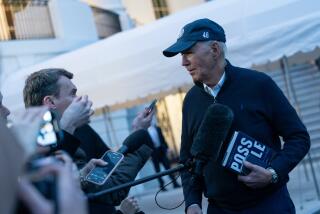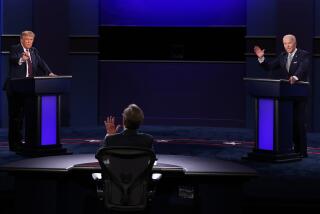It’s a Very, <i> er</i> , Important Field of, <i> um</i> , Study : Psychology: Professor seeks to learn why we all punctuate our speech with those meaningless sounds.
- Share via
To “er” is human.
You may think you’re articulate. You may see yourself as socially graceful. Even so, forget about trying to rid the filled pauses, or ums, from your patter.
Each person uses several hundred on a daily basis--and sometimes as many as 900 an hour, estimates UC San Diego psychologist Nicholas Christenfeld.
Christenfeld studies the um phenomenon, which also includes, well, like, er , you know. These filled pauses signal a time-out while the speaker grapples for the next word or thought. It’s the verbal equivalent of “bouncing a tennis ball before you serve,” said Christenfeld, who at 29 is the youngest member of UC San Diego’s psychology department.
Across the nation and in fact, around the world, people, well, um or eh or uh as they speak. It’s universal, says Christenfeld, an assistant psychology professor who claims that he himself is a man of few ums .
But Christenfeld is trying to figure out what he calls the fundamental question: why people utter um , especially since most believe it only makes them look fuzzy-headed.
“Why do people say um instead of sitting quietly--given that people don’t admire people who um ,” he said.
Christenfeld believes such utterances signal the individual’s desire to speak--though the actual words may elude the tip of the tongue, he says. It’s also a sign that the speaker is weighing his verbal options and ideas.
President Bush, for instance, averages 1.7 ums a minute while Vice President Quayle does 0.1 .
What does it mean?
“Either Quayle is a masterful speaker, a man of steel or he’s not contemplating many options when he speaks,” Christenfeld said. “I pick the latter.”
The White House declined to comment.
Asked if he has analyzed the frequency of filled pauses among the current presidential candidates, Christenfeld groaned. “It’s too painful.”
He has, however, examined the frequency of ums in the banter of several television talk show hosts because he believed that they got their jobs, in part, because of their ability to think and speak on their feet.
Johnny Carson utters 1.5 ums per minute; Arsensio Hall, 2.4; and David Letterman, 8.1, according to Christenfeld. (Pat Sayjack, who briefly hosted a talk show, spoke 9.8 ums per minute. “It’s amazing he lasted as long as he did,” Christenfeld said.)
Carson and Hall were unavailable to comment.
Letterman’s personal assistant, Laurie Diamond, said: “Here’s the thing, um , Dave’s in rehearsal.”
Christenfeld believes Letterman’s rate may be so high because he improvises more than the other talk show hosts analyzed.
“David Letterman certainly seems glib and facile,” Christenfeld said. “But Johnny Carson would probably say that experience counts.”
For four years now, Christenfeld, who specializes in speech disfluency, has studied um and er and uh --the topic of his graduate thesis at Columbia University . He’s also flirted with well and like but those are actual words that have meaning even if people do use them like conversational pepper.
But, clearly, Christenfeld has been won by ums , which, he confided, he usually cannot help counting--a habit that sometimes makes colleagues and acquaintances self-conscious.
“This is worth studying because it happens so much--anything that happens 10 times a minute is worth studying,” he said.
Working with Columbia psychology professor Stanley Schacter last year, Christenfeld found that the more choice of words you have in discussing a topic, the more ums you’ll use.
Examining 10 academic disciplines, he learned that literature and art historians um -ed almost four times more often than biologists and mathematicians. Natural scientists averaged 1.39 uhs per minute; social scientists, 3.84; and humanists, 4.85.
Schacter and Christenfeld explain this by maintaining that hard science professors must choose from a narrower, more specialized vocabulary when they speak. There is, for instance, no synonym for molecule or atom.
“Consider a statement such as E=mc 2. There are no options,” their study says. “In contrast, consider the statement, ‘What Shakespeare probably meant in that passage from Lear was . . . ‘ The options seem limitless.”
Today, in his quest to understand why people use filled pauses, Christenfeld is examining questions that include: How do people perceive a speaker saying um ? Do they think the person is more eager to speak if he says um ? Does he seem more intelligent? More interesting? Nervous or confident?
So far in his work, it does not appear that age, gender or class are a factor in how frequently a person uses a filled pause, said Christenfeld. But stress clearly affects how many ums you use. People talking to close friends will um about once or twice a minute. But those talking to their parole officer are apt to use about three times that rate, he said.
Christenfeld and UCSD psychology department chairwoman Laura Schreibman acknowledge that his work is, well, off beat. But nonetheless, they both believe it will ultimately help uncover significant aspects of human behavior.
“A lot of people might look at counting ums , and say why on earth would this be important?” Schreibman said. “Anything we do to better understand how our own behavior is affected by our social environment is very important.”
Does Christenfeld hope to understand why people say um so that it can one day be eliminated from speech?
“Oh no,” he said, “I’d be bored if we did that.”
The Um Report In a study of the “um” phenomenon--the filled pauses that signal a timeout when a speaker is grappling for the next word--UC San Diego psychology professor Nicholas Christenfeld determined that the complexity of the conversation topic determines the number of “ums.” Among the people and professions Christenfeld has surveyed: POLITICIAN/PERSONALITY: President Bush NUMBER OF “UMS” PER MINUTE: 1.7
POLITICIAN/PERSONALITY: Vice President Dan Quayle* NUMBER OF “UMS” PER MINUTE: 0.1
POLITICIAN/PERSONALITY: TV Evangelist Pat Robertson NUMBER OF “UMS” PER MINUTE: 7.9
POLITICIAN/PERSONALITY: TV talk show host David Letterman NUMBER OF “UMS” PER MINUTE: 8.1
POLITICIAN/PERSONALITY: TV talk show host Arsenio Hall NUMBER OF “UMS” PER MINUTE: 2.4
POLITICIAN/PERSONALITY: TV talk show host Johnny Carson NUMBER OF “UMS” PER MINUTE: 1.5
PROFESSORS/LECTURERS, Natural Sciences: Biology NUMBER OF “UMS” PER MINUTE: 1.13
PROFESSORS/LECTURERS, Natural Sciences: Chemistry NUMBER OF “UMS” PER MINUTE: 1.62
PROFESSORS/LECTURERS, Natural Sciences: Mathematics NUMBER OF “UMS” PER MINUTE: 1.29
PROFESSORS/LECTURERS, Natural Sciences: Psychology NUMBER OF “UMS” PER MINUTE: 1.50
PROFESSORS/LECTURERS, Social Sciences: Economics NUMBER OF “UMS” PER MINUTE: 2.17
PROFESSORS/LECTURERS, Social Sciences: Political science NUMBER OF “UMS” PER MINUTE: 5.61
PROFESSORS/LECTURERS, Social Sciences: Sociology NUMBER OF “UMS” PER MINUTE: 3.73
PROFESSORS/LECTURERS, Humanities: Art history NUMBER OF “UMS” PER MINUTE: 6.06
PROFESSORS/LECTURERS, Humanities: English literature NUMBER OF “UMS” PER MINUTE: 6.54
PROFESSORS/LECTURERS, Humanities: Philosophy NUMBER OF “UMS” PER MINUTE: 1.65
* Christenfeld says the low number indicates that either Quayle is a masterful speaker or he’s not contemplating many options when he speaks.





